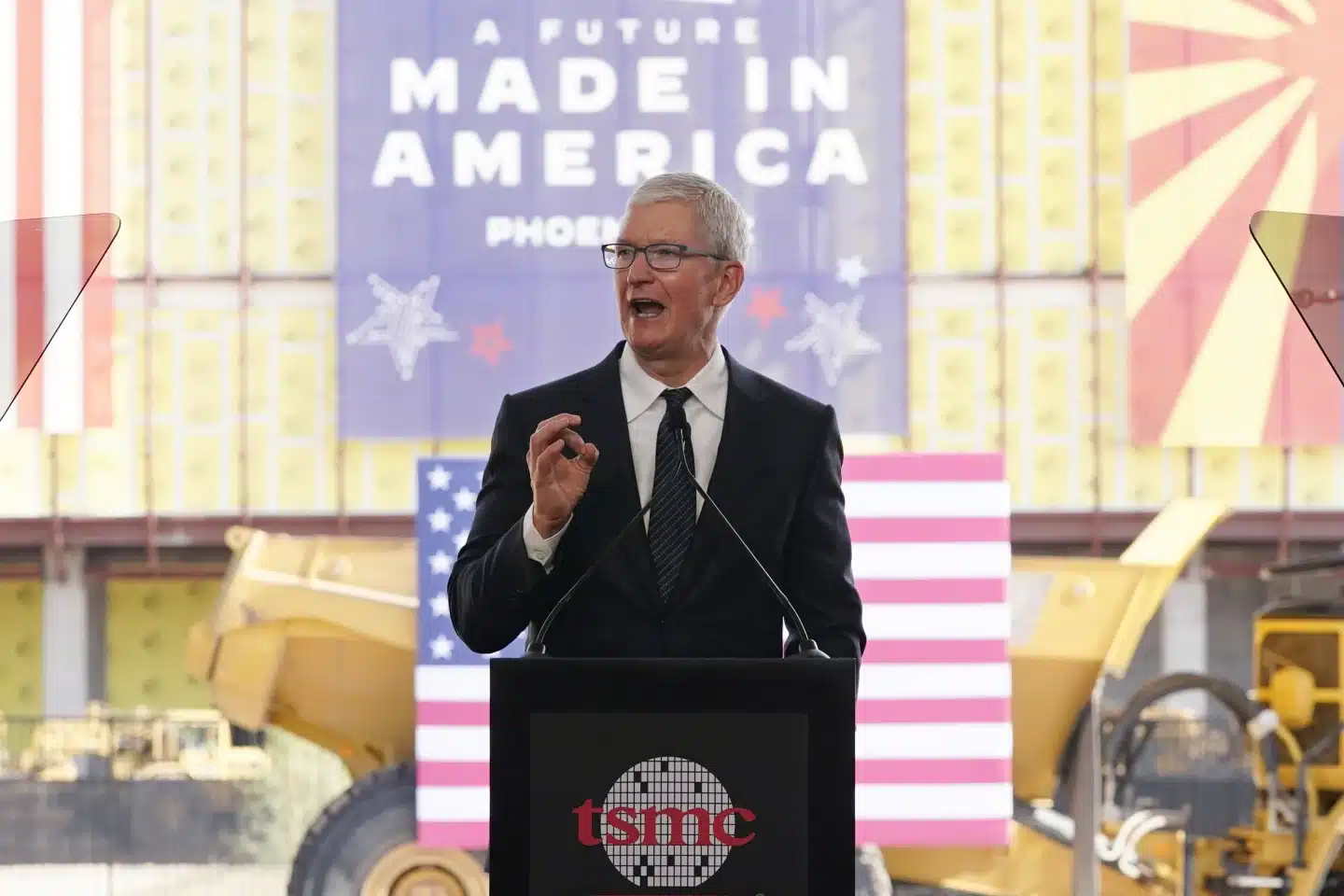Cryptocurrency
Global Inflation Pressures Could Become Harder To Manage In Coming Years, Research Suggests

JACKSON HOLE, Wyo. Trade restrictions are rising. Population ageing. A broad shift away from carbon-emitting fossil fuels and towards renewable energy.
The predominance of such tendencies could exacerbate global inflation pressures in the coming years, making it more difficult for the Federal Reserve and other central banks to fulfill their inflation targets.
This was a recurring topic in several high-profile speeches and economic research delivered Friday and Saturday at the Federal Reserve’s annual gathering of central bankers in Jackson Hole, Wyoming.
The global economy has been moving towards deeper integration for decades, with goods flowing more freely between the United States and its trading partners. Lower-wage production elsewhere allowed Americans to enjoy low-cost items while keeping inflation low despite losing many American industrial jobs.
That tendency, however, appears to be reversing since the outbreak. Global firms are relocating their supply chains away from China. Instead, They are attempting to make more items in the United States, particularly semiconductors, which are critical in creating automobiles and electrical goods, with the encouragement of substantial subsidies from the Biden administration.
Simultaneously, large-scale expenditures in renewable energy could be disruptive by boosting government borrowing and demand for raw materials, raising inflation. The world’s population is aging, and older people are less likely to continue working. These changes could operate as supply shocks, comparable to how shortages of products and labor drove inflation during the pandemic recession’s recovery.
Global Inflation Pressures Could Become Harder To Manage In Coming Years, Research Suggests
“The new environment sets the stage for larger relative price shocks than we saw before the pandemic,” European Central Bank President Christine Lagarde said in a speech Friday. “If we face both higher investment needs and greater supply constraints, we are likely to see stronger price pressures in commodity markets, particularly for metals and minerals critical to green technologies.”
This would complicate the work of the ECB, the Fed, and other central banks tasked with controlling price hikes. Almost all central banks are still fighting to contain the excessive inflation that began in early 2021 and has just partially abated.
“We live in a world where we can expect more and possibly larger supply shocks,” said Pierre-Olivier Gourinchas, chief economist of the International Monetary Fund, in an interview. “All of these things tend to make production more difficult and expensive.” And that is undoubtedly the combination that central banks despise the most.”
The changing trends in global trade patterns drew the greatest attention during Saturday’s Jackson Hole summit sessions. According to research by Laura Alfaro, an economist at Harvard Business School, China’s proportion of US imports declined 5% from 2017 to 2022 following decades of expansion. Her analysis ascribed the fall to US tariffs and the attempts of significant US corporations to locate alternative sources of goods and parts after China’s epidemic shutdowns hampered output.
Those imports were mostly from nations like Vietnam, Mexico, and Taiwan, which have better relations with the US than China – a trend known as “friendshoring.”
Global Inflation Pressures Could Become Harder To Manage In Coming Years, Research Suggests
Despite these developments, US imports reached an all-time high in 2022, indicating that total commerce remains strong.
“We are not deglobalizing yet,” Alfaro explained. “As trade patterns shift, we are witnessing a looming ‘Great Reallocation.'”
She also mentioned that there are early signs of “reshoring,” or the return of certain manufacturing to the United States. According to Alfaro, the United States is importing more parts and unfinished goods than before the pandemic, indicating that final assembly is taking place in the country. According to her, the fall in manufacturing jobs in the United States appears to have peaked.
However, Alfaro emphasized that these developments come with drawbacks: in the last five years, the cost of goods from Vietnam has climbed by approximately 10%, and items from Mexico have increased by about 3%, adding to inflationary pressures.
She also stated that China has increased its investment in manufacturing in Vietnam and Mexico. Furthermore, other countries that ship goods to the United States import components from China. These events indicate that the United States’ economic connections with China have remained strong.
At the same time, some global factors may act in the opposite direction, lowering inflation in the future years. One of these factors is slowing growth in China, the world’s second-largest economy after the US. With its economy in shambles, China will buy less oil, minerals, and other commodities, putting downward pressure on world prices.
Global Inflation Pressures Could Become Harder To Manage In Coming Years, Research Suggests
During a discussion on Saturday, Bank of Japan Governor Kazuo Ueda noted that while China’s stuttering growth is “disappointing,” it is primarily due to mounting defaults in the country’s bloated property sector rather than changes in trading patterns.
Ueda also criticized the United States’ growing use of subsidies to encourage domestic manufacturing during the last two years.
“The widespread use of industrial policy around the world may simply result in inefficient factories,” Ueda added, because they may not be positioned in the most cost-effective locations.
And World Trade Organisation Director-General Ngozi Okonjo-Iweala defended globalization while criticizing growing subsidies and trade obstacles. She claimed that global commerce frequently restrains inflation and has considerably reduced poverty.
“Predictable trade,” she explained, “is a source of disinflationary pressure, lower market volatility, and increased economic activity.”Economic fragmentation would be excruciating.”
SOURCE – (AP)
Cryptocurrency
Connor McDavid Wins Conn Smythe As Playoff MVP Despite Oilers Losing Stanley Cup Final To Panthers

SUNRISE, Florida – Connor McDavid earned the Conn Smythe Trophy as playoff MVP on Monday night, despite Edmonton’s Stanley Cup Final loss to Florida, in recognition of one of the best postseason performances in NHL history.
Despite being kept scoreless in the final two games, McDavid topped all postseason scorers with 42 points, five shy of Wayne Gretzky’s record of 47 set in 1985. He did not return from the locker room to receive the trophy from Commissioner Gary Bettman, leaving it on the stand while the Panthers celebrated nearby.
McDavid | AP News image
Connor McDavid Wins Conn Smythe As Playoff MVP Despite Oilers Losing Stanley Cup Final To Panthers
“It’s an honor with the names on that trophy, but yeah,” McDavid said.
McDavid placed first on 16 of 17 ballots. Panthers captain Aleksander Barkov finished second.
“I don’t think he cares,” longtime running mate Leon Draisaitl stated. “I mean, that shows how great of a hockey player he is. No player in the world wants to win the Stanley Cup more than him. He does everything properly every day, hoping to win one day. It’s incredibly hard because he’s unhappy and disappointed at the end.”
After going scoreless (but leading the team with three assists) in the first three games against Florida, McDavid shifted the course of the series by doing something no other player in history, including Gretzky, has done. He scored four points in two straight games in the finals to keep the Oilers from being eliminated.
“You think about the year that Connor had: 100 assists, leading our team, the performance he had in this playoffs, especially in this final round when we’re down three games to zero and then he comes out with eight points in two games,” the coach, Kris Knoblauch, said. “Yeah, he’s our leader, he’s our best player.”
After Flyers’ Reggie Leach in 1976, McDavid is only the second player to win the Conn Smythe on a team that lost in the final. Goaltenders Jean-Sebastien Giguere of Anaheim in 2003, Ron Hextall of Philadelphia in 1987, Glenn Hall of St. Louis in 1968, and Roger Crozier of Detroit in 1966 were also named playoff MVPs after backing up teams that fell short of winning the Cup.
Mcdavid | AP News Image
Connor McDavid Wins Conn Smythe As Playoff MVP Despite Oilers Losing Stanley Cup Final To Panthers
When asked how he was feeling over half an hour after the loss, McDavid could only say, “It sucks.”
McDavid, the reigning and three-time Hart Trophy winner widely regarded as the best hockey player in the world, put on a display in his maiden trip to the final. His goal and three helpers in an 8-1 victory in Game 4 prevented a sweep, and his four points, including an empty netter in Game 5 three nights later, returned the series to Alberta.
Those who know McDavid feel that his year-round effort throughout his career has helped him thrive when the spotlight shines brightest.
“He’s unique in his dedication to his craft,” said Hall of Famer Ken Hitchcock, McDavid’s coach in 2018-19. “He’s quite distinctive. He’s learned to be persistent, and he enjoys it. He’s really passionate about his craft, and that’s contagious when you’re on the same squad as him.”
Oilers teammates praised McDavid for setting a good example on and off the ice.
Mcdavid | AP News Image
Connor McDavid Wins Conn Smythe As Playoff MVP Despite Oilers Losing Stanley Cup Final To Panthers
“He’s the greatest player to ever play, in my opinion,” Draisaitl added. “There are so many things that he does that most people don’t notice, such as his work ethic. He almost singlehandedly turned our franchise around. I just love sharing the ice with him. He’s just a very remarkable person.”
That discussion is warranted for a player who led the league in scoring five times during the regular season and did almost everything on his own. What is still missing from the Stanley Cup, which will have to wait at least another year?
“Connor McDavid, he’s going to win the Stanley Cup someday,” said Patric Hornqvist, a two-time champion with the Pittsburgh Penguins who is now a Panthers scouting and development consultant. “That’s how good he is.”
SOURCE – (AP)
Cryptocurrency
How to Buy XEM P2b: Manage Your Finances and Returns

How do I buy XEM P2b? Blockchain and cryptocurrencies enable people to take control of their money in an ever-evolving financial landscape. XEM, the native digital asset of the New Economy Movement (NEM) blockchain network, is one such asset that enables users to have total financial control, manage an effective portfolio, and optimize high profits.
Let’s dig deep into the world of XEM and learn how to buy XEM P2B.
What is XEM P2B?
XEM is a digital asset created for the NEW network, which is based on economic freedom, decentralization, and equality. Furthermore, the platform is designed to manage assets and data efficiently and affordably.
XEM P2B is an acronym for New Economy Movement Platform to Business, and it is responsible for quickly processing business-to-business transactions. The breakthrough blockchain network has various characteristics to fulfill the needs of contemporary businesses, including scalability, security, and interoperability.
The platform streamlines the interchange of products and services while providing companies with future-proof and adaptable solutions. New technology, robust community support, smart alliances, and the ability to work with new technology make the platform an outstanding alternative for investors and traders.
Reasons for Buy XEM P2B
The crypto industry offers several platforms and digital assets for transactions, trades, and investments, but XEM P2B is successful owing to its practical qualities. A couple of the main characteristics are as follows:
Passive income opportunity: Participating in staking and network consensus enables investors to generate passive income. Individuals must stake in the XEM cryptocurrency to obtain rewards while encouraging a sustainable growth strategy.
Access to developing markets: Besides passive income and awards, the platform gives users access to emerging markets. Investing in the corresponding token closes the gap between the global and unbanked economies.
Top-notch security: The platform meets one of the most fundamental needs of businesses: security. XEM P2B prioritizes security by implementing an encryption protocol, proactive risk management strategies, and auditing methods.
XEM P2B also excels in regulatory compliance and governance, ecosystem growth, innovative creation, and market volatility hedging. The team behind the NEM platform is constantly working on new features, apps, and solutions for Decentralized Finance (DeFi) protocols and cross-border payments.
Furthermore, coordination with key companies and strategic partnerships in the cryptocurrency sector boosts the platform’s ecosystem. It also provides very quick transactions using the Proof-of-Importance (POI) method. The platform supports transaction speeds of up to 4K per second.
How do I buy XEM p2b?
After learning about the advantages and characteristics of buy XEM P2B, one should be interested in purchasing it. A few simple actions may help someone become an XEM holder. Here are several ways to buy XEM P2B directly from other users:
Platform selection: The first step in purchasing is to research and pick a renowned and dependable P2B platform. Individuals may evaluate platforms based on security features, costs, and payment options. LocalBitcoins, Binance P2P, and Hodl are other possibilities to consider.
Account opening: Once completed, the next step is establishing an account on the site and completing the KYC process. Meeting the standards provides security and transparency in the trading environment.
Offers Browsing: Users may browse available offers to purchase, sell, or exchange the native token. Price comparison, payment choices, and user reputations help you make the best decision.
Transaction initiation: After picking an appropriate offer, the next step is to begin a transaction with the seller. Fulfilling the agreed-upon conditions will assist both parties in commencing the transaction. The platform holds the money until the criteria are met.
Transaction completion: The last step is to complete the transaction by following the platform’s instructions. XEM is released to the user’s wallet after selecting a payment method and confirming the transaction.
Conclusion
Investing and trading in the XEM cryptocurrency enhances the portfolio, allows for better financial management, and generates passive income. Individuals may buy XEM P2B using LocalBitcoins, Binance P2B, and Hodl. Furthermore, the NEM blockchain provides superior security, rapid transactions, and access to new markets.
FAQs
What is the maximum supply of the XEM cryptocurrency?
The token’s maximum supply is 8,999,999,999 XEM.
Where can I get XEM P2B?
Individuals may trade XEM on Localbitcoins, Binance P2B, and Hodl.
More Related: DevelopSearcher.site: Improve Your Process of Development!
Cryptocurrency
ICO Crypto Token Launch Pads: Revolutionizing Crypto Fundraising and Investment

Overview of the ICO Crypto Token Launch Pads
An Initial Coin Offering (ICO) is the cryptocurrency industry’s version of an Initial Public Offering (IPO). Enterprises can raise cash to develop new cryptocurrency blockchain applications or services. Investors can participate in an ICO by purchasing the firm’s newly minted cryptocurrency, which may have utility related to the product or service or represent a share in the company. Notably, most ICOs are classified as security offerings and must comply with registration regulations.
Importance of ICO Launch Pad in the Cryptocurrency Business
ICO Crypto Launch Pads play an important part in the cryptocurrency sector. They act as platforms, facilitating the token issuance process for new projects. Launch Pads offer a standardized framework for executing ICOs, assuring regulatory compliance and increasing investor protection. These platforms serve as a conduit between companies and prospective investors, providing a safe and transparent environment for token offers.
Key advantages of employing a Launch Pad for token offerings:
Using an ICO Launch Pad benefits both project founders and investors. Launch Pads offer project creators access to a large investor base, increased credibility, and expedited token distribution processes. Launch Pads also provide investors with a selected selection of ideas, lowering the danger of fraud and allowing for early participation in promising ventures.
Furthermore, Launch Pads frequently include extra support services such as marketing, legal advice, and community building, increasing the likelihood of project success.
2. Key Components of an ICO Crypto Token Launch Pad
Project Selection Criteria for Launch Pads
ICO Launch Pads often use strict project screening criteria to ensure that only high-quality, legitimate projects are published on their platforms. These criteria could include the project team’s experience, the proposal’s validity, commercial potential, and technological innovation. Due diligence is carried out to reduce the danger of fraudulent or poorly designed projects.
Token distribution systems and processes.
Launch Pads play an important function in the token distribution process. They facilitate the issuance, sale, and allocation of tokens to investors. Launch Pads may use a variety of distribution mechanisms, including a fixed-price sale, a Dutch auction, or a tiered sales system. These procedures are intended to ensure fair and efficient token distribution while increasing the project’s fundraising potential.
The Function of Smart Contracts at ICO Launch Pads
Smart contracts, powered by blockchain technology, are critical components of ICO Launch Pads. They automate the token sale process, making it transparent, immutable, and secure. Smart contracts also allow for the automatic execution of predefined rules and circumstances, such as token distribution, vesting periods, and locking mechanisms. Launch Pads uses smart contracts to increase trust and eliminate the need for intermediaries in the token sale process.
3. Assessing ICO Projects on the Launch Pad
Due diligence procedure for evaluating ICO projects
ICO Launch Pads do extensive due diligence to determine the quality and legitimacy of projects they wish to list on their platforms. This process includes a thorough evaluation of the project team’s competence, the project’s business strategy, technical feasibility, and legal and regulatory compliance.
In addition, Launch Pads may seek external audits or expert opinions to verify a project’s claims and potential.
Risk assessment and mitigating measures
Launch Pads use rigorous risk assessment frameworks to identify and minimize hazards connected with the listed projects. These frameworks assess market, technical, regulatory, and operational risks. Launch Pads seeks to safeguard investors from fraudulent or failing initiatives while also promoting the long-term viability of the crypto ecosystem through rigorous risk assessments.
Ensure openness and credibility in ICO listings.
Transparency and credibility are important aspects of ICO launchpads. These platforms are designed to provide investors with credible and accurate information about listed projects. Launch Pads provide critical project information, such as the white paper, team profiles, fundraising targets, and token economics.
They also encourage open communication between project teams and the community, which promotes confidence and openness throughout the token sale process.
4. Maximizing Success in Launching Tokens through ICO Launch Pad
Marketing tactics to attract investors
To ensure the success of token releases, ICO Launch Pads use smart marketing methods. These techniques include social media campaigns, influencer collaborations, targeted advertising, and community involvement. Launch Pads also helps project founders develop a strong brand and communicate their value proposition to potential investors.
Developing a robust community around the token.
Community building is critical to the long-term viability of ICO ventures. ICO Launch Pads promote project teams’ interaction with the audience by providing regular updates, AMA (Ask Me Anything) sessions, and online forums. Launch pads frequently assist in organizing community events and encouraging active involvement. A strong and engaged community boosts the project’s legitimacy and increases the token’s liquidity and adoption rate.
After-launch token management and value proposition
ICO Launch Pads assist project teams in properly managing their tokens once the token sale has concluded. They facilitate the complicated terrain of cryptocurrency exchanges, liquidity provision, and token price stability. Furthermore, Launch Pads promotes continued communication between project teams and investors, providing transparency and regular updates on project progress. This post-launch support enables project teams to preserve investor confidence while delivering on their promised value offer.
5. FAQs
How can I take part in an ICO Crypto coin launch pad?
To participate in an ICO Crypto token launch pad, investors must first register an account on the relevant site. After completing the Know Your Customer (KYC) criteria, investors can browse the listed projects, study their details, and participate in token sales by following the Launch Pad’s instructions.
What are the advantages of releasing a token using an ICO Crypto platform?
Launching a token on the ICO Crypto platform provides several advantages, including access to a large pool of potential investors, increased credibility thanks to the platform’s due diligence process, streamlined token distribution mechanisms, and ongoing support services such as marketing and community engagement.
Are there any legal criteria to follow before establishing an ICO Crypto token?
There are legal procedures to consider when establishing an ICO Crypto token. The regulatory landscape differs by location, and project creators must follow applicable securities and banking legislation. Engaging legal counsel is critical for ensuring compliance and avoiding legal risks.
How can I guarantee the safety of my investment in an ICO Crypto token launch pad?
To safeguard the security of their investments in an ICO crypto token launch pad, investors should undertake extensive research and due diligence on the platform and the businesses featured on it. It is critical to assess the platform’s security procedures, including multi-factor authentication, secure fund storage, and smart contract audits. Furthermore, investors should be cautious and only invest what they can afford to lose.
In conclusion, ICO Crypto Token Launch Pads have transformed how cryptocurrency projects raise funding and interact with investors. These platforms offer a controlled and secure environment for launching tokens, increasing transparency and investor protection. ICO Launch Pads assist to the crypto industry’s long-term growth by adhering to rigorous project selection criteria, utilizing smart contract technology, doing due diligence, and encouraging community interaction.
-
World2 weeks ago
Former President Trump Survives Being Shot at Pennsylvania Rally
-
Tech4 weeks ago
Huawei Launches 5G-A Pioneers Program at MWC Shanghai 2024: Paving the Way for a Connected Future
-
Sports4 weeks ago
NBA Draft: Kyle Filipowski Withdraws Unexpectedly From The First Round
-
Tech4 weeks ago
ChatGPT Answers Undiscovered Questions and Outperforms Students.
-
News4 weeks ago
US Supreme Court Rejects Drug Deal that Protects the Sackler Family
-
Business4 weeks ago
Free Speech And Digital Rights Groups Argue TikTok Law Would Infringe On The First Amendment

















